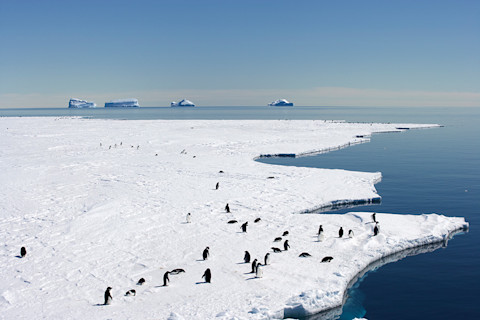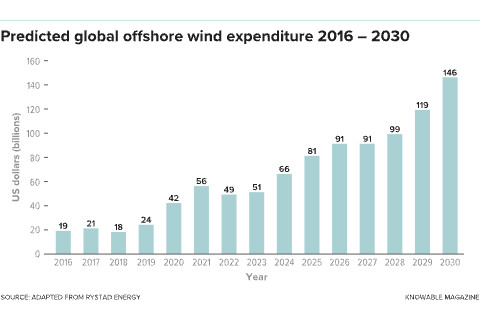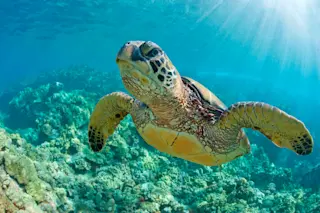Yes, we’ve got an ocean of bad news. Climate change is warming and acidifying seawater, stressing or destroying coral reefs. Marine species ranging from whales to algae are endangered; overfishing is crushing many subsistence fisheries.
Coastal ecosystems have been wiped out on a grand scale; key ocean currents may be faltering; mining firms are preparing to rip up the deep seafloor to harvest precious minerals, with unknown ecological costs. And let's not even talk about ocean pollution.
But there’s good news, too, says Nancy Knowlton, a coral reef biologist at the Smithsonian National Museum of Natural History. In fact, she says, many marine conservation efforts around the globe are seeing good results.
“There are a lot of successes out there, and most people don’t know about them,” Knowlton says. It’s important to share those successes, she adds, to avoid paralyzing feelings of hopelessness and to spread the knowledge of approaches that work. That’s why she and her allies began pushing the #oceanoptimism Twitter hashtag in 2014. Organizations such as Conservation Optimism and the Cambridge Conservation Initiative have broadened her theme, helping to share conservation stories, findings, resolve and resources.
In marine conservation, “successful efforts typically are neither quick nor cheap and require trust and collaboration,” Knowlton wrote in a 2020 Annual Review of Marine Science paper promoting ocean optimism. Focusing on success stories, she stressed, helps motivate people to work toward new successes.
Here are glimpses of a few bright spots in the pitched battle for the blue planet.
Some High-Profile Conservation Efforts Are Already Paying Off.
An international moratorium on commercial whale hunting that started in the 1980s has shown dramatic results, even though a few species are still hunted by several countries and indigenous groups. While some whale populations remain very much in trouble — the North Atlantic right whale, for instance, is critically endangered — others are rebounding. The population of humpback whales in the western South Atlantic, which had dropped to around 450 in the 1950s, now is estimated at around 25,000 — near the level scientists estimate existed before hunting began. The International Whaling Commission estimates the global population of these whales now may be around 120,000 animals. Blue, bowhead, fin and sei whale populations are also growing globally, according to the International Union for Conservation of Nature.
Sea turtles are another success story. Most populations of turtles included in a recent survey were found to be growing, even though the animals must be protected on both land and sea. In Florida, scientists estimate that the population of green turtle nests climbed from 62 in 1979 to 37,341 in 2015. And in Texas, Kemp’s Ridley turtle nests rose from just 1 to 353 over roughly the same time period, Knowlton notes.
Many Fisheries Are Reasonably Well Managed.
In many areas, the ocean is dangerously overfished. But the world’s most valuable fisheries, which make up roughly 34 percent of global captures, are relatively healthy in general, environmental economists Christopher Costello of the University of California at Santa Barbara and Daniel Ovando of the University of Washington in Seattle wrote in the 2019 Annual Review of Environment and Resources.
Hot debates continue about the status of many species that were massively overfished for decades. But there is good evidence that sustainable management is now being achieved for some species in some regions. According to the UN’s Food and Agriculture Organization, 34.2 percent of the world’s marine fisheries are currently overfished, but harvests have held relatively steady for fisheries ranging from Alaska pollock to European sardines (pilchards) to Indian mackerel and yellowfin tuna.
On the high seas beyond national jurisdiction, fishing vessels largely operate without legal restrictions, and sometimes hundreds of vessels will target a given region and make huge hauls. Such incidents may suggest that the unregulated high seas “would be a tremendous threat to sustainability of the world’s fisheries,” Costello and Ovando wrote. “Somewhat incredibly, this does not appear to be the case.” Among the likely explanations: High seas fishing accounts for only 6 percent of global fish catch; pursuing highly mobile and unpredictable species such as tuna can be extremely expensive; and regional fisheries management organizations do watch over many catches in the high seas.

The US Coast Guard prepares to board and inspect a fishing vessel in the North Pacific in 2019. Ramped-up patrols like these are helping to reduce illegal fishing. (Credit: US Coast Guard/Knowable Magazine)
US Coast Guard/Knowable Magazine
The high seas may come under better control through a United Nations treaty on marine biodiversity, which may be finalized next year after many years of meetings. This would greatly broaden the international resources available for proper fisheries management anywhere on the ocean.
Moreover, technology is changing the game in fisheries enforcement, says Heather Koldewey, a senior technical advisor at the Zoological Society of London. Organizations such as Global Fishing Watch and Ocean Mind track large fishing vessels via satellite imaging, making it easy to track suspicious activities such as clusters of vessels in a protected zone. In 2019, for example, after Global Fishing Watch partnered with the US Coast Guard in the Pacific, the patrol tripled its number of fishing vessel boardings. Also in 2019, Ocean Mind joined with Interpol and several nations and successfully tracked and seized an illegal fishing vessel in Indonesia.
There’s also hope for an end to the large governmental subsidies given to high-seas fisheries that are ecologically unsustainable and also, by World Trade Organization assessment, don’t make economic sense. Each year, China, the European Union, the United States and others give about $35 billion of subsidies to their fishing industries, many of them high-seas fleets going after populations that can’t sustain the attack. Without these large subsidies, “as much as 54 percent of the present high-seas fishing grounds would be unprofitable,” estimated marine biologist Enric Sala of the National Geographic Society and his coauthors in a 2018 Science Advances paper.
Finalizing years of negotiations to reduce these subsidies will be a high priority for WTO Director-General Ngozi Okonjo-Iweala.
Marine Protected Areas Are Rapidly Expanding and Could Play a Hugely Positive Role.
Marine protected areas are regions of the ocean designated to guard ecosystems that may be particularly crucial for preserving biodiversity or withstanding specific severe threats. Almost 8 percent of the ocean has been structured as MPAs, although less than half of that area is fully protected against fishing and loss of other resources. Coverage is growing — for instance, in April 2021 the European Commission and 15 countries announced support for two MPAs that would protect more than 3 million square kilometers of the Southern Ocean off Antarctica.

Among the reasons to be hopeful: Two marine protected areas are planned for swaths of the Southern Ocean off Antarctica. (Credit: John Weller/Knowable Magazine)
John Weller/Knowable Magazine
Safeguarding marine environments, MPAs also offer major benefits to human communities, such as reestablishing fish populations that can be sustainably fished just outside their waters. An analysis of the Papahānaumokuākea Marine National Monument off Hawaii, the third-largest protected area in the world, found “little, if any, negative impacts on the fishing industry,” according to a 2020 Nature Communications article. And in Southern California, MPAs preventing fishing in 35 percent of one coastal area led to a 225 percent increase in spiny lobster catch after just six years, scientists reported in a 2021 Scientific Reports paper.
A worldwide “30 by 30” initiative seeks to protect at least 30 percent of the globe by 2030, with backers including the G7 group of wealthy industrial nations.
Some Progress Is Being Made in the Global Struggle Against Pollution.
OK, nothing like the progress that is needed. But there are some happy stories, although they may take decades for the payoffs to be evident, says Carlos Duarte, a marine ecologist at King Abdullah Science and Technology University in Saudi Arabia.
One example is a series of governmental restrictions that began in the 1970s to ban leaded fuels in vehicles, a major source of ocean pollution. During a global expedition in 2010 and 2011, Duarte and colleagues looked at levels of lead across the ocean and found they had dropped to negligible. “By banning leaded fuels, we actually restored the whole ocean within 30 years,” he says.
Oil spilled into the ocean from tankers has also dropped dramatically over the decades, primarily due to steady tightening of regulations and conventions like the International Maritime Organization’s International Convention for the Prevention of Pollution from Ships.
True, plastics are a global garbage disaster. Although public awareness has climbed dramatically, as much as 23 million metric tons of plastic waste still enter aquatic systems each year, according to a 2020 article in Science. This megaproblem must be solved primarily upstream, in manufacture and use, says Marcus Eriksen, an environmental scientist at 5 Gyres Institute in Santa Monica, California. “Today, the optimism is around the innovators, the private sector rising to the challenge to fill the consumer need without the externalities of pollution,” he says. Eriksen points to manufacturers ramping up production of innovative biomaterials such as microbially synthesized polymers called polyhydroxyalkanoates, or PHAs, that are designed to be fully degradable by microbes in the ocean and other natural environments.

Greener plastics under development hold hope for less plastic trash in the ocean. But products must be tested under real-world conditions. In an experiment, plastic products treated in various ways — such as submerged under a dock for 2 years — did not degrade as fast or well as advertised. (Credit: 5Gyres.org/Knowable Magazine)
5Gyres.org/Knowable Magazine
We Know How to Restore Crucial Coastal Ecosystems Such As Mangroves at Large Scale.
Vast stretches of healthy coastal ecosystems have been lost to pollution, urban expansion, conversion for aquaculture and other human activities. But not all the news is bad — take mangroves, for instance, which make enormous contributions to biodiversity, fisheries, storm protection and carbon storage on warm coastlines around the world.
“We’ve seen a slowdown of the losses of mangroves and in many regions of the world we’re starting to see an increase,” says Duarte. “We are very, very capable of restoring mangroves at scale, and I think it’s doable to restore them to almost their historical extent within the next 30 years.”
The most dramatic example, Duarte adds, is the restoration of 1,400 square kilometers of Vietnam’s Mekong Delta mangrove forest, destroyed by the US Air Force in the 1970s. “When I worked there in the late 1990s, if I wasn’t a trained mangrove ecologist I would have thought I was in a pristine mangrove forest,” he says. “And that mangrove sequesters an amount of carbon that is very significant compared to the emissions of Vietnam, which has a huge positive role in mitigating climate change.”
The 2004 Indian Ocean tsunami that killed roughly a quarter of a million people helped to shift international thinking about the importance of defending and reestablishing mangrove forests, Duarte says. Judging by analyses of the tsunami’s impact published later, “it was clear that in the villages where there was a pocket of mangrove sheltered between the shoreline and the village, there was almost no human cost,” he says. “Even property losses were severely reduced.”
In the Philippines, too, some mangrove forests are being recovered after decades in which half of them were lost, mostly to aquaculture ponds or coastal development, says Koldewey. “We’ve made huge progress in science-based but community-led mangrove restoration projects,” she says. “Within five years, they’re functioning, trapping loads of carbon, stopping waves eroding shore or damaging people and habitats, and doing their mangrove thing.”
It’s important, though, that these efforts are done right. (To learn more, see Knowable Magazine’s article on mangrove restoration.) Key to success, researchers have learned, are selecting the right mangrove species and planting them in the right locations — and being sure to involve local communities.
Mangroves aren’t the only types of coastal ecosystems being renewed around the world. Salt marshes and oyster reefs are also being restored on a large scale in Europe and the US, Duarte and colleagues note in a 2020 Nature paper. One recent study, for example, counted 140 saltmarsh restoration projects in Europe, and massive efforts are underway in Louisiana and Florida. “Restoration attempts of seagrass, seaweed and coral reef ecosystems are also increasing globally, although they are often small in scale,” the Nature authors add.
Offshore Wind Is Rapidly Ramping Up to Deliver Clean Energy on a Global Scale.
Ocean wind technologies are proven around the world, and often are highly competitive with other energy sources, especially with the advent of larger turbines and other engineering advances. By one estimate, this year the global installed offshore wind capacity will climb 37 percent.
These giant offshore wind factories will deliver enormous amounts of energy with very low levels of greenhouse gases, offering “an important potential for wind energy to really make a big contribution to going carbon neutral,” Knowlton says. In 2019, the International Energy Agency estimated that close-to-shore offshore wind sites have the potential to provide more than the current global electricity demand. Offshore turbines do bring ecological risks, including damage to marine ecosystems, interference with fisheries and threats to birds, but leading environmental groups see those risks as quite acceptable with proper design and management. “It’s past time to push for more offshore wind,” the Sierra Club declared in March 2021.

Spending on offshore wind energy is projected to rise, offering a cleaner energy option to the world.
Optimism Breeds Action.
Of course, marine scientists can’t forget the enormous threats to the ocean for a second. “We’re not being naive,” says Koldewey. “There’s a lot of bad news, but we’re balancing the narrative with: How do we solve it? There are reasons to be optimistic and everybody has a role to play in being part of the solution.”
Duarte has become more hopeful in the past few years, as growing signs of conservation success crop up around the world, often from efforts launched decades ago. Taking on the challenge to heal the oceans will be hugely difficult, “but if we don’t do it now, a decade from now it will be impossible,” he says. “We made a goal to stop grieving about the ocean, to accept the loss and then engage in action — because we still have the capacity to reverse much of the losses and turn over a healthy ocean to our grandchildren.”
10.1146/knowable-080521-1
Eric Bender, a science writer in Newton, Massachusetts.
This article originally appeared in Knowable Magazine, an independent journalistic endeavor from Annual Reviews.














